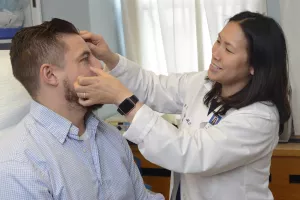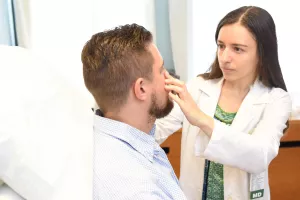Skin cancer is the most common type of cancer affecting all people. The most common forms of skin cancer are basal cell carcinoma or squamous cell carcinoma. Skin cancer can also take a more aggressive, malignant form known as melanoma.
Keep a watchful eye on skin changes
More skin cancers are diagnosed each year than all other cancers combined. When diagnosed early on, skin cancer is curable. There are steps you can take to stay ahead of your skin health, like routine skin evaluations with your dermatologist, especially if you or your family has a history of skin cancer.
It's important to speak with your dermatologist if you notice changes to your skin, like pink discoloration, peeling, swelling or crusting. These could be warning signs of skin cancer. Because your skin is your body's largest organ, and it's always regenerating itself, we encourage you to watch for any unusual changes.

Conditions
The 3 main types of skin cancer are basal cell carcinoma, squamous cell carcinoma and melanoma. Skin cancers can also take different forms, including:
Basal cell carcinoma
Basal cell carcinoma is the most commonly diagnosed form of skin cancer each year. In fact, about 75% of the over 2 million cases of basal cell carcinoma and squamous cell carcinoma diagnosed each year are basal cell carcinoma. This number continues to rise.
Basal cell carcinoma rarely spreads beyond the initial site of the tumor. This form of cancer is very treatable with early detection and treatment.
Basal cell carcinoma can occur anywhere on your skin's surface. Places that are most exposed to the sun — such as the head, face, hands, forearms and legs — are the most commonly affected sites of basal cell carcinoma.
Keep an eye out for these common basal cell carcinoma symptoms:
- Bleeding
- Crusting
- Peeling
- Pink discoloration
- Swelling
- Thickening
- Ulceration
These signs and symptoms can also mimic benign skin conditions, such as eczema or acne. The big difference between benign conditions and skin cancer is that skin care lesions won’t heal on their own, and they often worsen despite good skin care practices.
If you notice any of these signs, it’s a good idea to get evaluated by a healthcare provider.
Squamous cell carcinoma
About 25% of the over 2 million cases of basal cell carcinoma and squamous cell carcinoma diagnosed each year are squamous cell carcinoma. This number continues to rise.
Squamous cell carcinoma tends to spread locally, and is easily treatable with early intervention. It rarely spreads to the lymph nodes, so it's unlikely that squamous cell carcinoma will become aggressive.
Squamous cell carcinoma can occur anywhere on your skin, although most cases occur in areas that are regularly exposed to sun, such as the head, face, hands, forearms and legs.
Talk with your doctor if you notice any of these symptoms that could point to squamous cell carcinoma:
- Pink discoloration
- Peeling
- Swelling
- Ulceration
- Bleeding
- Thickening
- Crusting
These signs and symptoms can also mimic benign skin conditions, such as eczema or acne. The big difference between benign conditions and skin cancer is that skin care lesions won’t heal on their own, and they often worsen despite good skin care practices.
If you notice any of these signs, it’s a good idea to get evaluated by a healthcare provider.
Melanoma
Melanoma is the sixth most common cancer in the United States (separate from skin cancer being the overall most common), and is increasing faster than any other cancer. While there are approximately 160,000 new cases of melanoma worldwide each year, this only represents 1.5% of all newly diagnosed cancers.
Melanomas occur most often in sun-exposed areas of the skin, such as the head, face and extremities.
Dermatologists use the ABCDE acronym when detecting melanoma:
- A: Asymmetry in shape and appearance
- B: Border irregularities, like jagged or uneven edges
- C: Color variegation
- D: Diameter greater than 6 mm (larger than a pencil eraser)
- E: Evolution in color, shape or symptoms
Testing
Squamous and basal cell carcinoma have key features that dermatologists can flag as suspicious with the naked eye. To confirm what we've seen, we often use dermatoscopes, which help identify features of the cancer cells.
They'll double-check their suspicions by taking a small sample of skin tissue — known as a biopsy — to test if the lesion is benign or cancerous.
If the cancer is relatively small, your dermatologist can remove the affected area on the spot so that you can leave our office with healthy skin the same day.
If the skin cancer is larger and has spread beyond its local site, your dermatologist will schedule a follow-up appointment to discuss the next steps.
Treatments
Skin cancer treatment depends on several factors, including:
- The size, type and location of the cancer
- The chances that the cancer is aggressive or likely to recur
- Your preferences regarding the appearance of the area after treatment
Some skin cancers are considered superficial, meaning the cancer cells spread slowly and appear on the skin's surface. We can remove these mild to moderate tumors by:
- Freezing the tumors (cryosurgery)
- Removing the tumors with electrical currents (electrosurgery)
- Prescribing medicated creams (topical therapy)
Other skin cancer tumors are more aggressive and may require one or more of the following approaches:
- Surgery
- Chemotherapy
- Immunotherapy (using the body's natural immune responses to fight cancer)
- Radiation treatment
When your skin cancer calls for more advanced surgical care, we answer with a surgical treatment that has a cure rate of up to 99%. We're proud to be the first health system in New England to offer you Mohs micrographic surgery.
Mohs micrographic surgery
Mohs surgery is a smart option for skin cancer that's in a visible or hard-to-treat area, like the face or hands. The good news is that Mohs surgery has a cure rate of up to 99% for people with basal or squamous cell skin carcinoma.
Additionally, it has a cure rate of up to 95% for people who have tumors that didn't respond to more traditional skin cancer treatments.
If you undergo Mohs surgery, you'll have peace of mind knowing that we remove cancerous tumors and have you home all in the same day. Here's how Mohs surgery works:
- You'll first receive local anesthesia around the affected area
- Your surgeon then removes and evaluates one skin layer at a time
- This process is repeated until the tumor is eliminated

From regular office visits to inpatient stays, find the healthcare you need and deserve close to home.

Meet the doctors and care team devoted to supporting you every step of the way along your path to better health.